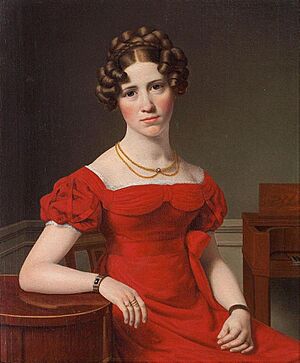Johan Georg Forchhammer facts for kids
Quick facts for kids
Johan Georg Forchhammer
|
|
|---|---|

Forchhammer, c. 1850
|
|
| Born |
Johan Georg Forchhammer
26 July 1794 Husum, Duchy of Schleswig (now Germany)
|
| Died | 14 December 1865 (aged 71) Copenhagen, Denmark
|
| Resting place | Assistens Cemetery |
| Spouse(s) |
Louise Christiane Fugl
(m. 1825) |
| Children | Johannes Forchhammer |
| Scientific career | |
| Fields | Geology, chemistry |
| Institutions | University of Copenhagen, Technical University of Denmark |
| Academic advisors | Hans Christian Ørsted |
Johan Georg Forchhammer (born July 26, 1794 – died December 14, 1865) was a famous Danish scientist. He was a mineralogist, which means he studied minerals, and a geologist, who studies the Earth's rocks and history.
Contents
Early Life and Learning
Johan Georg Forchhammer was born in a place called Husum, which was then part of Schleswig. He went to university to study science. From 1815 to 1818, he studied at the University of Kiel and the University of Copenhagen.
A Career in Science
After finishing his studies, Forchhammer joined two other scientists, Hans Christian Ørsted and Lauritz Esmarch. They went on an adventure to explore the minerals on the island of Bornholm. Forchhammer played a big part in this important trip.
In 1820, he earned his doctorate degree. This is a very high academic degree, and his research was about a chemical element called manganese. Soon after, he traveled through England, Scotland, and the Faroe Islands.
Teaching and Research
Forchhammer became a lecturer at the University of Copenhagen in 1823. He taught about chemistry and mineralogy. Later, in 1829, he also started teaching at a new technical school. By 1831, he became a professor of mineralogy at the university. In 1848, he took charge of the geological museum.
He helped map the geology of Denmark from 1835 to 1837. When Hans Christian Ørsted passed away in 1851, Forchhammer took over his roles. He became the director of the technical school and the secretary of the Royal Danish Academy of Sciences and Letters.
Forchhammer also worked with other scientists on studies about humans, which became very well-known. He was a great teacher and helped science grow in Denmark. He also cared about practical things, like bringing gas lighting to Copenhagen and setting up the fire brigade.
Forchhammer's Principle
In 1865, Johan Georg Forchhammer made a very important discovery about seawater. He suggested that the main salts in seawater are always found in the same proportions, no matter where you take the sample from. This idea is now known as Forchhammer's Principle or the Principle of Constant Proportions.
His idea was later proven correct in 1884 by Professor William Dittmar. This happened after a huge study of seawater samples collected during the Challenger expedition, a famous scientific voyage around the world.
Personal Life
Johan Georg Forchhammer was married twice. His first wife was Louise Christiane Fugl, whom he married in 1826. Sadly, she passed away in 1831.
He then married her half-sister, Emilie Mariane Fugl. They lived in a special house in Copenhagen called the Professor's House. They lived there from 1833 until Forchhammer's death in 1865.
Forchhammer had one child from his first marriage, a son named Johannes Forchhammer. Johannes grew up to be a linguist, someone who studies languages. He also became a headmaster at two schools. Forchhammer's second marriage did not have any children.
Johan Georg Forchhammer passed away on December 14, 1865. He is buried in the Assistens Cemetery.
Awards and Recognition
Forchhammer was a respected member of the Royal Danish Academy of Sciences and Letters starting in 1825. He received the Order of the Dannebrog in 1939 and was made a Commander of the Order in 1860.
In 1862, he was also chosen as a member of the American Philosophical Society. This shows how important his scientific work was around the world.
Images for kids




